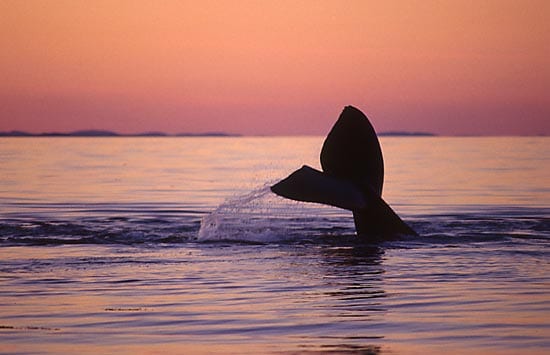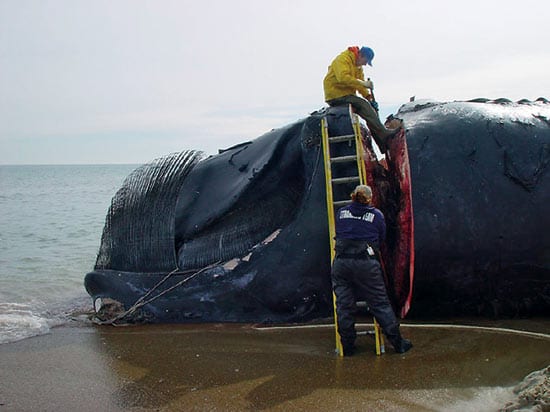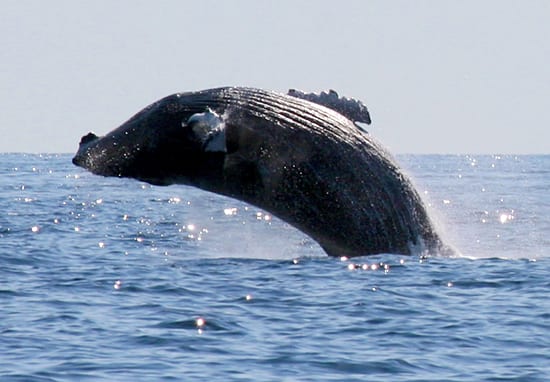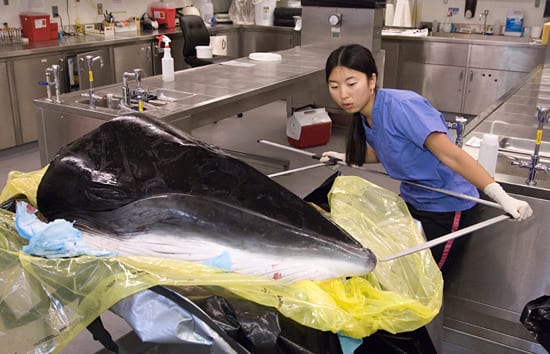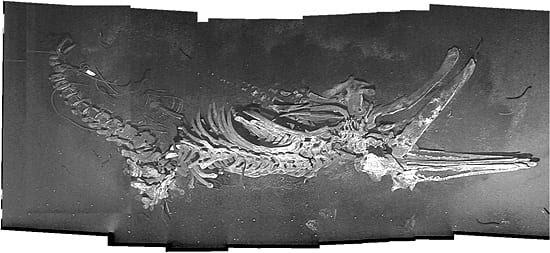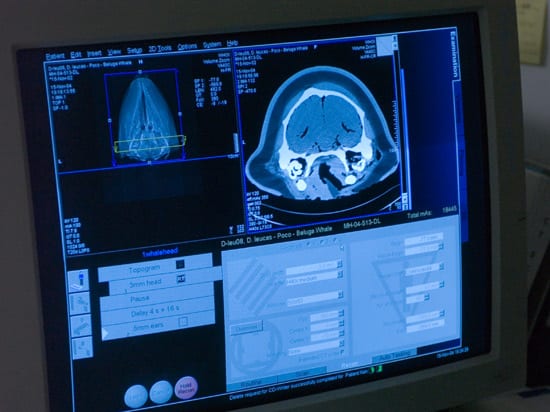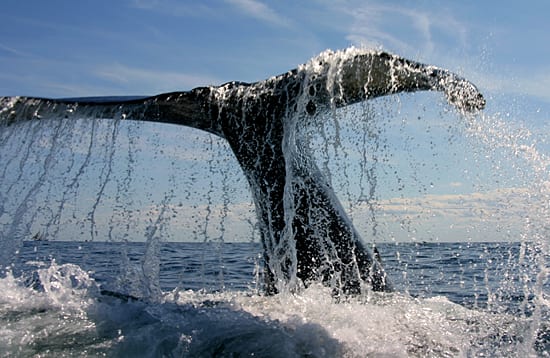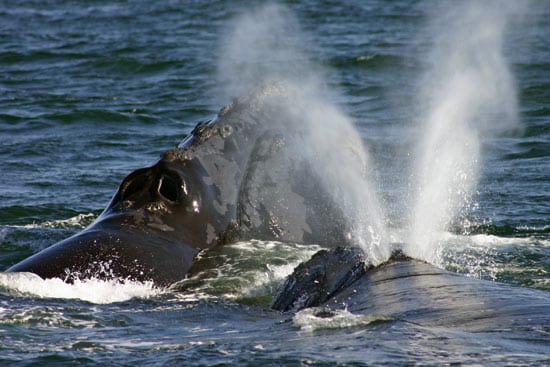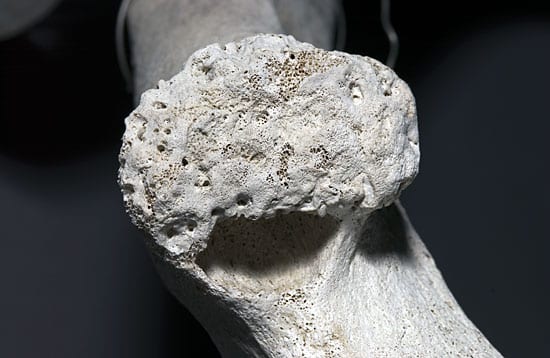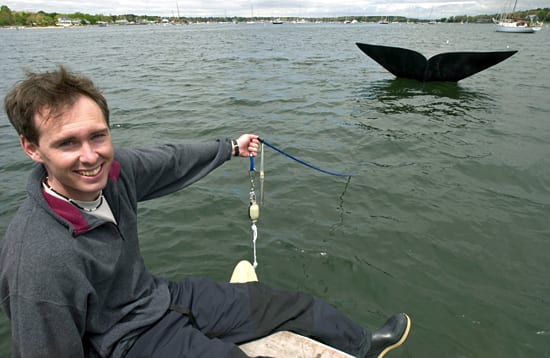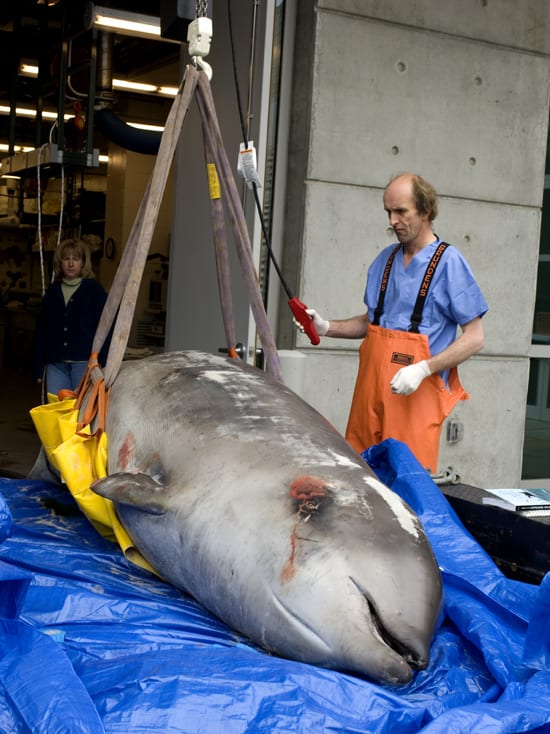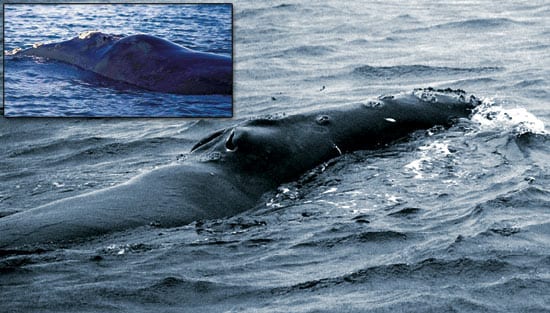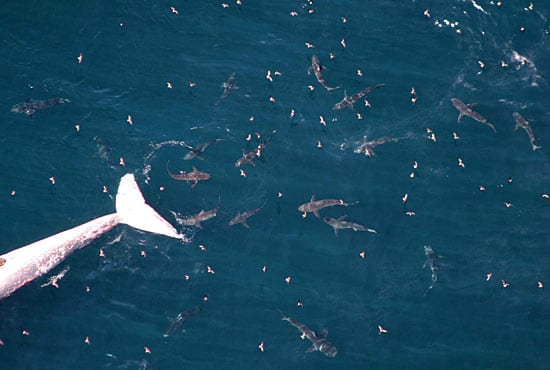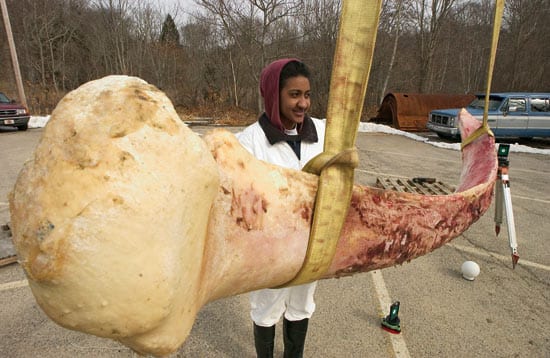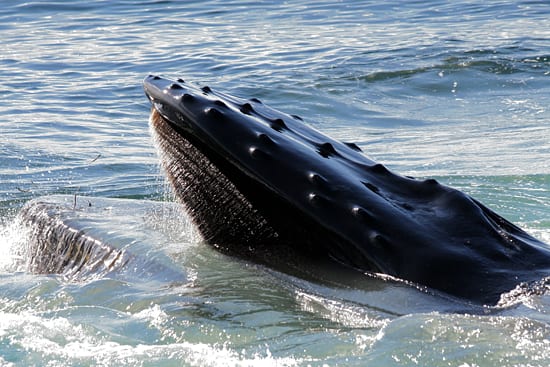- A North Atlantic right whale dives in search of food near Grand Manan Island in the Bay of Fundy, Canada. (Photo by Michael Moore, Woods Hole Oceanographic Institution)
- WHOI biologist Michael Moore (top) begins a necropsy to determine what killed this right whale. (Photo by Regina Campbell-Malone, Woods Hole Oceanographic Institution)
- A humpback whale (Megaptera novaeangliae) breached while WHOI researchers were working to tag whales near Stellwagen Bank. No one knows for sure why whales breach the water surface; some researchers believe it is a form of communication among whales. (Photo by Melissa Patrician, Woods Hole Oceanographic Institution)
- Summer Student Fellow Maya Yamato measures the head of a minke whale—Balaenoptera acutorostrata—that WHOI researchers were asked to investigate in the new necropsy lab at WHOI's Marine Research Facility. WHOI biologists contribute to several regional and national efforts to understand what causes deaths to marine mammals. (Photo by Tom Kleindinst, Woods Hole Oceanographic Institution)
- The skeleton of a dead whale was intentionally sunk off the coast of San Diego in order to study how "whale falls"—when whales die at sea and drop to the ocean floor—serve as oases of life for other creatures. To date, more than 20 such whale-fall ecosystems have been found. The images for this photomosaic were taken by cameras on the submersible Alvin. (Photomosaic courtesy of Hanumant Singh, Woods Hole Oceanographic Institution)
- A computer screen in the WHOI CT scan facility shows a scan of the head of a beluga whale. The CT scan is used forensically to investigate why animals died and/or stranded themselves on beaches. It is also used to examine ear anatomy of marine mammals and other animals to examine how animals hear. (Photo by Tom Kleindinst, Woods Hole Oceanographic Institution)
- The fluke of a humpback whale (Megaptera novaeangliae) creates its own waterfall. Researchers get up close and personal with whales while tagging them with harmless transmitters for studies of the food chain of Stellwagen Bank, from tiny plankton to bus-sized whales. (Photo by Melissa Patrician, Woods Hole Oceanographic Institution)
- Ship strikes threaten the survival of the endangered North Atlantic right whale. About 300 to 350 animals remain. This photo was taken in 2004 during fieldwork in the Bay of Fundy. (Photo by Regina Campbell-Malone, Woods Hole Oceanographic Institution)
- TELLTALE CLUES—A spherical lesion found in a rib of a dead sperm whale that beached on Nantucket was likely caused by nitrogen bubbles hat formed when the whale rose too rapidly from high-pressure depths. The bubbles obstruct blood flow and lead to bone damage. (Photo by Tom Kleindinst, Woods Hole Oceanographic Insitution)
- Jeremy Winn (University of Maine) harnesses a fiberglass replica of a right whale's tail during tests with WHOI scientists in Marion Harbor, Mass. Scientists are trying to find ways to slow down whales to disentangle them from fishing gear. (Photo by Tom Kleindinst, Woods Hole Oceanographic Institution)
- Michael Moore prepares a 12-foot Cuvier's beaked whale (Ziphius cavirostris) for a necrospy at the new necropsy/CT scanning facility at WHOI for forensic studies to try to determine what may have caused it to strand and die. (Photo by Tom Kleindinst, Woods Hole Oceanographic Institution)
- A southern right whale (inset) shows a roll of fat behind its blowhole, which northern right whales often lack. WHOI research indicates that southern right whales (unlike northern right whales) may have increased their population because they are getting adequate nutrition to achieve successful pregnancies. (Photos by Carolyn Angell, Woods Hole Oceanographic Institution)
- An airplane pilot's view of mako, blue, and dusky sharks, as well as seabirds, feeding on a decomposing finback whale, first seen floating about 24 miles southeast of Nantucket on Sept. 9, 2005. The pilot estimated about 200 sharks near the whale during his flight Sept. 11. That afternoon, all but four or five of the sharks scattered when the research vessel Tioga arrived with marine scientists interested in studying the whale. (Photo by Tim Voorheis, Gulf of Maine Productions)
- Graduate student Regina Campbell-Malone studies the structure and properties of whale jawbones to determine how they stand up to impacts from ship collisions. (Photo by Tom Kleindinst, Woods Hole Oceanographic Institution)
- A humpback whale (Megaptera novaeangliae) takes a gulp of water and fish, while tiny sandlances jump out of its mouth. The sandlance, commonly known as a "sand eel," is a stick-like fish that is prime target for hungry humpbacks who come to Stellwagen Bank (off Massachusetts) in the summer. Researchers have been studying the many strands and layers of the food web on the Bank to try to understand why it is such a productive feeding ground. (Photo by Melissa Patrician, Woods Hole Oceanographic Institution)
patrician-HW_breach_34116_41545.jpg
SEARCH RELATED TOPICS: Marine Mammals
Image and Visual Licensing
WHOI copyright digital assets (stills and video) contained on this website can be licensed for non-commercial use upon request and approval. Please contact WHOI Digital Assets at images@whoi.edu or (508) 289-2647.
